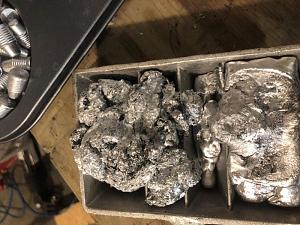
|
   
   
|


|
My guess wold be the small stuff is Linotype and it's pretty high in antimony. I had a large bucket of it years back until it grew legs.
Individual small type and the letter blocks are typically monotype. Had to be stronger structurally than the longer type of Linotype (get it, ‘line’) so more antimony. Below is some I just had tested in Oct.


The small stuff is curious, doesn’t fit the way most does. If it’s all asian characters then that may explain it.
I’d have it tested.
A few years ago I bought some monotype with an unknown amount of linotype mixed in. I cast some ingots and had it tested and the results are:
Pb 74.4%
Sn 6.91%
Sb 16.71%
Cu 1.37%
Not sure to what extent these results are due to the linotype, and what are due to normal depletion by use. I just take it at face value and adjust accordingly.
John
W.TN
I believe the individual letters with the notch on the back are Foundry Type. Its pretty common for the stuff to be mixed up with other kinds of type.

nice find.
Thanks for the replies. I used a Lee hardess tester on the big blocks and it came out 30-33 so I'd also lean towards foundry lead. The real issue are those small ones. Huge amount have Asian symbols on them as noted above. I put 2 lbs of range scarp in the melter than though in a small hand full and had a mess. High melting temp, "Foamy" outmealish, fluxed a couple time with a wax still no luck. Flowed terribly, had to hit it with a torch. I'm starting to think zinc, any change these are just super high in Sb? They are extremely brittle, and hard. How does one get testing doe?

You need to do the acid test for zinc. It shouldn't fizz with HCL/muriatic acid.

My guess if monotype/foundry --- single letters/characters. The only way I know to tell is by hardness testing
*** NEVER SMELT IN YOUR CASTING POT *** You toss in something funky and it may take a lot of wire brushwork to get the pot clean enough for casting again.
Single letters are monotype = "mono" as "single".
Linotype name for the strips comes from "line 'o' type".

The foamy oatmealish stuff is antimony (mostly) and tin that floats on the surface as it comes up to temp. Raise your melt temp a little and take your time smashing it against the side of the pot while you incorporate it back into the melt. Don't get over enthusiastic with the smashing. Let it get up to temp and take your time getting it mixed back in. It's usually all good.
The small stuff is a mix of foundry and monotype.


This is correct. That is how you tell the difference. You will not find lino alloy in single letters of type. That is not how the machines worked!
I own 4 antique printing presses with probably 60 different FULL type faces for them. they can have 0, 1 ,2 , or 3 notches in the back. Used for identifying. Use the above chart when mixing your alloys.
Old printer's type has a lot of oxide on it and that will float on the surface of your pot. That is normal.
And I would highly recommend keeping EVERYTHING in it's original native format and NOT melting down into ingots. You cannot prove what is in the ingots if you ever want to sell it. Everybody knows what is in mono/foundry/lino because of the shape and form.
bangerjim
Some one on this forum used to trade out lead for zinc,, Worth a shot ; )
H/D

Send a sample to BNE. Find out what it truly is. There might be some who would want it. Your mistake was heating to 942 degrees. keep under 700 degrees and zinc can't get melted into your mix.

While zinc melts at 787 F and antimony melts at 1167, they will dissolve into a lead solution given some time. It is a slow process but does result in combining with the lead. That is why you remove zinc COWW from the melt as quickly as you can when melting and cleaning the WW and pouring into ingots.


I have 6 pt thru 240 pt complete font sets. Depending on the maker, the notches vary. But all my type is at least 150 years old. I have seen "newer" stuff made from 100% Zn, especially larger logo and advertising blocks, and it looks like that is what he has.
Did I read "a foreign language font" somewhere in there? Heaven only knows what they used over there! My type sets are 100% US made and all hard alloy like they should be from the good olde daze.
| BP | Bronze Point | IMR | Improved Military Rifle | PTD | Pointed |
| BR | Bench Rest | M | Magnum | RN | Round Nose |
| BT | Boat Tail | PL | Power-Lokt | SP | Soft Point |
| C | Compressed Charge | PR | Primer | SPCL | Soft Point "Core-Lokt" |
| HP | Hollow Point | PSPCL | Pointed Soft Point "Core Lokt" | C.O.L. | Cartridge Overall Length |
| PSP | Pointed Soft Point | Spz | Spitzer Point | SBT | Spitzer Boat Tail |
| LRN | Lead Round Nose | LWC | Lead Wad Cutter | LSWC | Lead Semi Wad Cutter |
| GC | Gas Check |